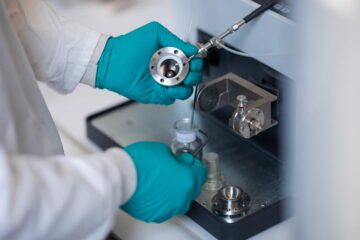Micro microwave does pinpoint cooking for miniaturized labs

In a paper in the November 2007 Journal of Micromechanics and Microengineering*, the research team led by NIST engineer Michael Gaitan describes for the first time how a tiny dielectric microwave heater can be successfully integrated with a microfluidic channel to control selectively and precisely the temperature of fluid volumes ranging from a few microliters (millionth of a liter) to sub-nanoliters (less than a billionth of a liter).
Sample heating is an essential step in a wide range of analytic techniques that could be built into microfluidic devices, including the high-efficiency polymerase chain reaction (PCR) process that rapidly amplifies tiny samples of DNA for forensic work, and and methods to break cells open to release their contents for study.
The team embedded a thin-film microwave transmission line between a glass substrate and a polymer block to create its micro microwave oven. A trapezoidal-shaped cut in the polymer block only 7 micrometers across at its narrowest—the diameter of a red blood cell—and nearly 4 millimeters long (approximately the length of an ant) serves as the chamber for the fluid to be heated.
Based on classical theory of how microwave energy is absorbed by fluids, the research team developed a model to explain how their minature oven would work. They predicted that electromagnetic fields localized in the gap would directly heat the fluid in a selected portion of the micro channel while leaving the surrounding area unaffected. Measurements of the microwaves produced by the system and their effect on the fluid temperature in the micro channel validated the model by showing that the increase in temperature of the fluid was predominantly due to the absorbed microwave power.
Once the new technology is more refined, the researchers hope to use it to design a microfluidic microwave heater that can cycle temperatures rapidly and efficiently for a host of applications.
Media Contact
More Information:
http://www.nist.govAll latest news from the category: Power and Electrical Engineering
This topic covers issues related to energy generation, conversion, transportation and consumption and how the industry is addressing the challenge of energy efficiency in general.
innovations-report provides in-depth and informative reports and articles on subjects ranging from wind energy, fuel cell technology, solar energy, geothermal energy, petroleum, gas, nuclear engineering, alternative energy and energy efficiency to fusion, hydrogen and superconductor technologies.
Newest articles

Security vulnerability in browser interface
… allows computer access via graphics card. Researchers at Graz University of Technology were successful with three different side-channel attacks on graphics cards via the WebGPU browser interface. The attacks…

A closer look at mechanochemistry
Ferdi Schüth and his team at the Max Planck Institut für Kohlenforschung in Mülheim/Germany have been studying the phenomena of mechanochemistry for several years. But what actually happens at the…

Severe Vulnerabilities Discovered in Software to Protect Internet Routing
A research team from the National Research Center for Applied Cybersecurity ATHENE led by Prof. Dr. Haya Schulmann has uncovered 18 vulnerabilities in crucial software components of Resource Public Key…





















